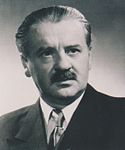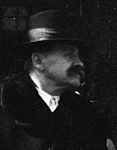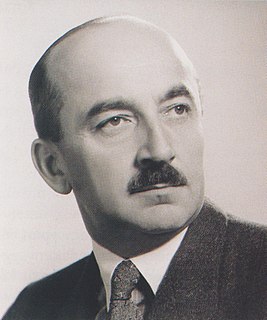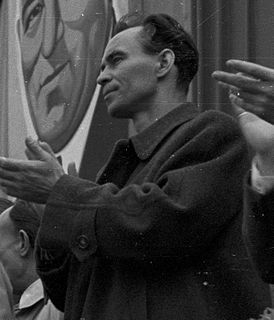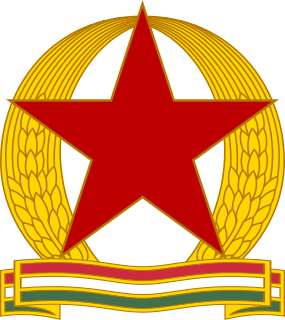
The State Protection Authority was the secret police of the People's Republic of Hungary from 1945 until 1956. It was conceived as an external appendage of the Soviet Union's secret police forces and gained an indigenous reputation for brutality during a series of purges beginning in 1948, intensifying in 1949 and ending in 1953. In 1953 Joseph Stalin died, and Imre Nagy was appointed Prime Minister of Hungary. Under Nagy's first government from 1953 to 1955, the ÁVH was gradually reined in.

The Hungarian Working People's Party was the ruling communist party of Hungary from 1948 to 1956. It was formed by a merger of the Hungarian Communist Party (MKP) and the Hungarian Social Democratic Party. Ostensibly a union of equals, the merger had actually occurred as a result of massive pressure brought to bear on the Social Democrats by both the Hungarian Communists, as well as the Soviet Union. The few independent-minded Social Democrats who had not been sidelined by Communist salami tactics were pushed out in short order after the merger, leaving the party as essentially the MKP under a new name.

János Kádár was a Hungarian communist leader and the General Secretary of the Hungarian Socialist Workers' Party, presiding over the country from 1956 until his retirement in 1988. His 32-year term as General Secretary covered most of the period the People's Republic of Hungary existed. Due to Kádár's age, declining health and declining political mastery, he retired as General Secretary of the party in 1988 and a younger generation consisting mostly of reformers took over.

Ernő Gerő[ˈɛrnøː ˈɡɛrøː] was a Hungarian Communist Party leader in the period after World War II and briefly in 1956 the most powerful man in Hungary as the second secretary of its ruling communist party.
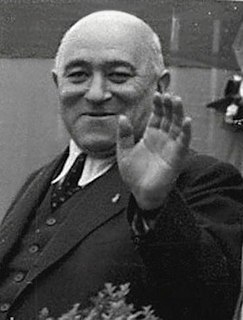
Mátyás Rákosi[ˈmaːcaːʃ ˈraːkoʃi] was a Hungarian communist politician. He was born Mátyás Rosenfeld in Ada. He was the leader of Hungary's Communist Party from 1945 to 1956 — first as General Secretary of the Hungarian Communist Party (1945–1948) and later holding the same post with the Hungarian Working People's Party (1948–1956). As such, from 1949 to 1956, he was the de facto ruler of Communist Hungary. An ardent Stalinist, his government was very loyal to the Soviet Union, and he presided over the mass imprisonment of hundreds of thousands of people and the death of thousands. American journalist John Gunther described Rákosi as "the most malevolent character I ever met in political life."
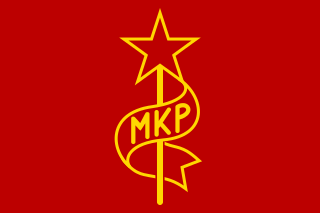
The Party of Communists in Hungary, renamed Hungarian Communist Party in October 1944, was founded on November 24, 1918, and was in power in Hungary briefly from March to August 1919 under Béla Kun and the Hungarian Soviet Republic. The communist government was overthrown by the Romanian Army and driven underground. The party regained power following World War II and held power from 1945 under the leadership of Mátyás Rákosi. In 1948 the party merged with the Social Democrats to become the Hungarian Working People's Party. The Communist Party of Hungary was a member of the Communist International.

István Dobi was a Hungarian politician who was the Prime Minister of Hungary from 1948 to 1952. He was the first Communist to hold the post, joining the party shortly after it seized full control of the country in 1949.

The Christian Democratic People's Party is a Christian-democratic political party in Hungary. It is officially a coalition partner of the ruling party, Fidesz, but is in reality a satellite party of Fidesz and has been unable to get into the Parliament on its own since 2006. For several elections prior to the pact, they had been unable to pass the election threshold of 5% of the vote. Without Fidesz, its support cannot be measured, and even a leading Fidesz politician, János Lázár, stated that Fidesz does not consider the government to be a coalition government.

The Hungarian People's Republic was a one-party socialist republic from 20 August 1949 to 23 October 1989. It was governed by the Hungarian Socialist Workers' Party, which was under the influence of the Soviet Union pursuant to the 1944 Moscow Conference during which Winston Churchill and Joseph Stalin had agreed that after the war Hungary was to be included in the Soviet sphere of influence.

Hungarian–Soviet relations were characterized by political interventions by the Soviet Union in internal Hungarian politics for 45 years, the length of the Cold War. Hungary became a member of the Warsaw Pact in 1955; since the end of World War II, Russian troops were stationed in the country, intervening at the time of the Hungarian Revolution of 1956. Starting in March 1990, the Soviet Army began leaving Hungary, with the last troops being withdrawn on June 19, 1991.

Parliamentary elections, which later became infamously the "blue-ballot" elections, were held in Hungary on 31 August 1947. The Hungarian Communist Party, which had lost the previous election, consolidated its power in the interim using salami tactics. This fact, combined with the weakening of the opposition and a revised electoral law, led to further Communist gains. It was Hungary's last remotely competitive election before 1990.

Parliamentary elections were held in Hungary on 15 May 1949. The Hungarian Independent People's Front, an umbrella group created that February to replace the National Independence Front and led by the Hungarian Working People's Party, but also including the remaining four non-communist parties, ran a single list of candidates espousing a common programme. With all organised opposition having been paralaysed, the Front won 95.6% of the vote, presaging the result of elections through 1990. 71 (17.7%) elected deputies were female, up from 22 (5.4%) elected in 1947. Some 71% of those elected belonged to the Working People's Party, and a similar proportion were workers or peasants.

The Second Hungarian Republic was a parliamentary republic briefly established after the disestablishment of the Kingdom of Hungary on 1 February 1946 and was itself dissolved on 20 August 1949. It was succeeded by the People's Republic of Hungary.

Guilty of Treason is a 1950 American drama film directed by Felix E. Feist and starring Charles Bickford, Bonita Granville and Paul Kelly. Also known by the alternative title Treason, it is an anti-communist and anti-Soviet film about the story of József Mindszenty, a Roman Catholic cardinal from Hungary. Mindszenty spoke out against the Nazi occupation of his country during World War II, as well as the later Communist regime. Because of his opposition to the Soviet regime, Mindszenty was arrested and tortured. After his release, he took refuge in the US Embassy in Budapest for many years, maintaining his support for the Hungarians who wanted an end to the Russian occupation.
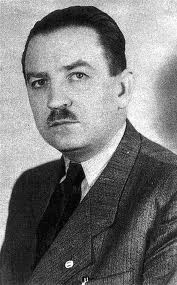
Béla Kovács was a Hungarian politician, who served as Minister of Agriculture from 1945 to 1946 and in the Hungarian Revolution of 1956.
The Statute XIX of 1937 regarding establishing of a National Council when the Regent seat is vacant was a 1937 law of the Kingdom of Hungary. The National Council (Országtanács) would be an interim collective head of state.

The Hungarian Soviet Republic or literally Republic of Councils in Hungary was a short-lived communist rump state. When the Republic of Councils in Hungary was established in 1919, it controlled only approximately 23% of the territory of Hungary's classic borders.
The Independent Hungarian Democratic Party was a political party in Hungary in the period after World War II. The party was revived after the end of communism in 1989–90, but remained unsuccessful.
The Hungarian Freedom Party, was a short-lived right-wing political party in Hungary between 1946 and 1947, it strongly opposed the Communist takeover. The party was revived for a short time during the Hungarian Revolution of 1956 and after the end of communism in 1989–90.



